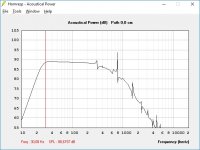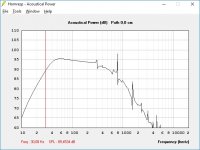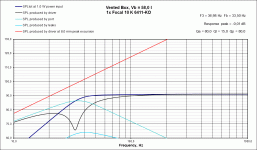Example,
2 Seas L26RFX In a 100L box tuned to 20hz need 90watts to play 109db/50hz
2 Accuton S280 in a 100L box tuned to 30hz need 45watts to play 109db/50hz
Cone excursion of the seas (50hz)is 5.7mm X sd330cm=1.88L x 2= air displaced 3.76L
Cone excursion of the accuton (50hz) is 3.3mm X sd408cm=1.34L x 2 air displaced 2.68L
So at the same sound level the seas will produce more bass?
2 Seas L26RFX In a 100L box tuned to 20hz need 90watts to play 109db/50hz
2 Accuton S280 in a 100L box tuned to 30hz need 45watts to play 109db/50hz
Cone excursion of the seas (50hz)is 5.7mm X sd330cm=1.88L x 2= air displaced 3.76L
Cone excursion of the accuton (50hz) is 3.3mm X sd408cm=1.34L x 2 air displaced 2.68L
So at the same sound level the seas will produce more bass?
Why are you comparing 50hz numbers when the tuning is 30hz and 20hz?
The Accuton has more SD (Accuton 408 > Seas 330), but the Seas has slightly more travel (Accuton 12mm p-p < Seas 14mm p-p).
Other than the Accuton being about 8 times more expensive, I should think that in the exact same box the drivers should perform very close to each other.
The Accuton has more SD (Accuton 408 > Seas 330), but the Seas has slightly more travel (Accuton 12mm p-p < Seas 14mm p-p).
Other than the Accuton being about 8 times more expensive, I should think that in the exact same box the drivers should perform very close to each other.
Don't forget the contribution of the port to displacement.
This is an important point. Cone excursion is minimized at the box tuning frequency, where port output is maximized. As you move away from the tuning frequency the port output decreases and cone excursion increases. Going up in frequency you reach a frequency where excursion (for a target SPL) is at a maximum. This happens at about 1.5 times the tuning frequency. Further increases in frequency require less excursion for a given SPL.
In this comparison the 30Hz tuned box is making a bigger contribution at 50Hz than the 20Hz tuned box (50Hz being closer to 30Hz than 20Hz), so it is reducing the needed excursion for your chosen SPL.
I just thought it was more like an apples to pears comparison, mainly because of the box tuning.
So my point was exactly what you said in plain english TBTL.
Was just hoping Shure would discover it.
Is it really? The reason I chose 20 and 30hz was becouse that give me the flattest respons in a 100L box, the size I want to use them in.
The reason I chose 50hz was becouse that was the lowest hz in same spl.
So If I tune them both to 20hz it would look like this.
Cone excursion of the seas (37hz)is 7mm X sd330cm=2.31L x 2= air displaced 4,6L
Cone excursion of the accuton (37hz) is 4.2mm X sd408cm=1.71L x 2 air displaced 3.42L
37hz is max excursion for both.
It's just that your numbers do not make sense to me.
Why would you make a 100 liter box with TWO of these drivers? Especially if you want max flat response to 30hz, you should see that 100 liters is only enough for ONE of these drivers. Or have you not considered practical port length and/or port area/size properly?
What program are you using anyway? Do you have any design goals?
Edit:
And where do you get those SPL numbers from 1/pi or 0,5/pi?
Edit2:
Here's what I get with a single seas in 93 liters. 2/pi 2,83v
Why would you make a 100 liter box with TWO of these drivers? Especially if you want max flat response to 30hz, you should see that 100 liters is only enough for ONE of these drivers. Or have you not considered practical port length and/or port area/size properly?
What program are you using anyway? Do you have any design goals?
Edit:
And where do you get those SPL numbers from 1/pi or 0,5/pi?
Edit2:
Here's what I get with a single seas in 93 liters. 2/pi 2,83v
Attachments
Last edited:
Winisd, perhaps not the program to use?
Im using 2 seas today in a 100l box tuned to 20hz in a 3way up to 250hz.
Im only curious what would happen if I would change them to accuton.
And Im just trying to figure out why some woofers sound thin and others have more bass at the same spl and thought it could be becouse of how much air the woofer moves.
Im using 2 seas today in a 100l box tuned to 20hz in a 3way up to 250hz.
Im only curious what would happen if I would change them to accuton.
And Im just trying to figure out why some woofers sound thin and others have more bass at the same spl and thought it could be becouse of how much air the woofer moves.
It may be that I've misunderstood something, but my memory firmly states that the simulations in Winisd is box volume + port volume. So a 100 liter box in winisd wants an external went to perform like the simulation, IE port volume is IN ADDITTION TO box volume.
Feel free to correct me, my memory is very unreliable.
If you are seriously considering changing to the Accuton drivers, there is a long list of other options I would consider first, in new boxes. Mainly because of cost in relation to performance. My personal assumption: those Seas vs Accuton's you're comparing, not night and day difference.
Edit:
Here is that very same box at 93 litres (including port), only with 2 drivers in parallel, as you can see, there is 3db increase of SPL due to doubled displacement, and 3db increase due to increased power (because of half impedance), note that because the box size restricts low frequency performance the gain at 30hz is hardly worth noting at all. Throwing power out the window and wasting potential of your expensive drivers.
Looks good from 40 hz up though. But you might as well use a sealed box.
Edit2:
Have you tried just putting a single sock, or maybe two, loosely in each port? Maybe you can coax out some different bass behaviour making the port more resistive.
Feel free to correct me, my memory is very unreliable.
If you are seriously considering changing to the Accuton drivers, there is a long list of other options I would consider first, in new boxes. Mainly because of cost in relation to performance. My personal assumption: those Seas vs Accuton's you're comparing, not night and day difference.
Edit:
Here is that very same box at 93 litres (including port), only with 2 drivers in parallel, as you can see, there is 3db increase of SPL due to doubled displacement, and 3db increase due to increased power (because of half impedance), note that because the box size restricts low frequency performance the gain at 30hz is hardly worth noting at all. Throwing power out the window and wasting potential of your expensive drivers.
Looks good from 40 hz up though. But you might as well use a sealed box.
Edit2:
Have you tried just putting a single sock, or maybe two, loosely in each port? Maybe you can coax out some different bass behaviour making the port more resistive.
Attachments
Last edited:
Yes the accuton is very expensive and may not be worth the upgrade.
But seas and accuton aside we can choose any driver we want with similar size.
What im thinking is that choosing one woofer over another only becouse it can play lower doesn't mean it will play more bass but the air displacement must be taken into consideration aswell to get more bass?
But seas and accuton aside we can choose any driver we want with similar size.
What im thinking is that choosing one woofer over another only becouse it can play lower doesn't mean it will play more bass but the air displacement must be taken into consideration aswell to get more bass?
Allright. At the risk of repeating stuff you may already know:
Part of the reason why a proper well designed Bass Reflex works, is that the resonant behaviour of the vent coupled with the internal volume of the box, at specific frequencies, sort of reflect forces that again work against the drivers movement. If it was a closed box, the movement of the driver at a specific power level would increase the lower the frequency.
With the Reflex box, the reflective forces will eventually be greater than the movement of the driver, until eventually the vent does not cause resonant behaviour at even lower frequencies, and the driver has further increased excursion than it would if it was a closed box. IE, at a low enough frequency, the vent creates all the sound, not the driver. But below this frequency again, there is no gain.
With a BR design, you are just pushing the point of increased excursion lower in frequency.
At the very basics, yes, moving more air equals more bass. But it depends heavily on type of enclosure and size of enclosure. As a general rule, a big box will make more bass at the same power level than a small box, but this again, depends on the properties of the driver chosen for the design.
Also, a big driver with low xmax but high surface displacement has the potential for lower distortion than a small driver with higher xmax but low surface displacement, even if the potential for moving air is equal. Another thing to consider, is force cancelation, if you have opposing woofers on each side or front/back of an enclosure, they have the potential to cancel each others vibrational forces, further reducing unwanted effects.
Part of the reason why a proper well designed Bass Reflex works, is that the resonant behaviour of the vent coupled with the internal volume of the box, at specific frequencies, sort of reflect forces that again work against the drivers movement. If it was a closed box, the movement of the driver at a specific power level would increase the lower the frequency.
With the Reflex box, the reflective forces will eventually be greater than the movement of the driver, until eventually the vent does not cause resonant behaviour at even lower frequencies, and the driver has further increased excursion than it would if it was a closed box. IE, at a low enough frequency, the vent creates all the sound, not the driver. But below this frequency again, there is no gain.
With a BR design, you are just pushing the point of increased excursion lower in frequency.
At the very basics, yes, moving more air equals more bass. But it depends heavily on type of enclosure and size of enclosure. As a general rule, a big box will make more bass at the same power level than a small box, but this again, depends on the properties of the driver chosen for the design.
Also, a big driver with low xmax but high surface displacement has the potential for lower distortion than a small driver with higher xmax but low surface displacement, even if the potential for moving air is equal. Another thing to consider, is force cancelation, if you have opposing woofers on each side or front/back of an enclosure, they have the potential to cancel each others vibrational forces, further reducing unwanted effects.
Last edited:
The short answer is no. Comparing 2 drivers, if at a specific frequency one moves more air than the other, then you can conclude that it has more SPL capability at that specific frequency alone only if the drivers have the same efficiency (i.e. same base SPL), and only if they are in a closed box.Moving more air means more bass right?
IMHO you are approaching this in the wrong way. Air displacement doesn't mean anything in a BR box. You have to look at the combined driver+tube output and not the driver's alone. At tuning, the sound comes from the tube and not from the driver, have a look at the attached picture. If you want to compare two drivers use a decent box simulator and see what happens changing box volume and tuning frequency, those parameters will affect the bass extension and its shape. Max SPL is determined by the T/S parameters of the driver.What im thinking is that choosing one woofer over another only becouse it can play lower doesn't mean it will play more bass but the air displacement must be taken into consideration aswell to get more bass?
Ralf
Attachments
- Status
- This old topic is closed. If you want to reopen this topic, contact a moderator using the "Report Post" button.
- Home
- Loudspeakers
- Multi-Way
- Air displacement


